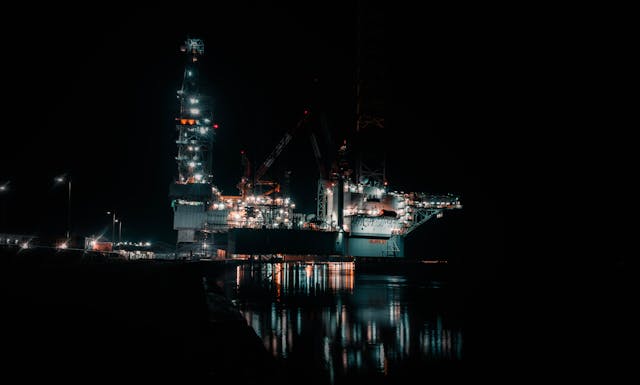Deep offshore technology constantly evolves due to the demand for more environmentally friendly, effective, and safer solutions. The importance of locating and extracting oil and gas from offshore areas is rising as global energy demand increases. We must continue to generate novel concepts to address the issues in deep-sea habitats. We will examine the most recent advancements in marine engineering and offshore drilling, revolutionising how we explore and extract resources from the deep sea.
Since the first platforms were built, offshore drilling has made a lot of progress in terms of technology. Drilling in deeper waters has made it possible to explore resources that were once thought to be out of reach thanks to modern technology. These upgrades not only make the system work better, but they also make it safer and less harmful to the environment. Many important new technologies have changed offshore drilling in a big way. It is now easier than ever to get more resources from the ocean floor.
Advanced Methods for Drilling
Developing more advanced drilling techniques is one of the most significant improvements in deep offshore technology. For example, directional drilling lets you accurately target oil and gas reserves. Companies can reach many reservoirs from one spot by angling the drill bit. This cuts down on expenses and environmental impact. This level of accuracy also reduces surface damage and makes resource extraction more effective.
Also, better drilling methods like Managed Pressure Drilling (MPD) and Extended Reach Drilling (ERD) are becoming more popular. MPD helps control the annular pressure profile, which lowers the chances of blowouts and other drilling dangers. On the other hand, ERD makes drilling operations stretch farther horizontally, making it possible to reach reserves far away from the drilling site. These methods have made it easier to explore new places, especially in locations sensitive to the environment.
Floating Production Systems
Floating Production Systems Another crucial new idea is floating production systems (FPS). These systems are made to extract and process hydrocarbons on-site, so there is no need for large, fixed platforms. FPS units are handy in deep and ultra-deep waters where building traditional platforms is impossible. They are flexible and can be moved to different sites, which saves money and makes operations more efficient. Additionally, integrating FPS with Floating Storage and Offloading units (FPSOs) improves storing and offloading processed hydrocarbons directly onto tankers. This reduces the need for pipeline infrastructure, which can be expensive and complicated to install in deep-sea environments. The adaptability and mobility of FPS and FPSO units make them useful in modern offshore operations, especially in remote and harsh conditions.
Marine Engineering Breakthroughs
AUVs, or Autonomous Underwater Vehicles
AUVs, or autonomous underwater vehicles, are becoming increasingly popular in offshore work. These robotic submarines don’t have anyone on board and can do many things, like explore the seabed, check pipelines, and monitor the environment. AUVs can work in challenging underwater circumstances and gather useful information without putting people in danger. Because they can do complicated jobs independently, they are essential for keeping the undersea infrastructure safe and sound.
Also, innovations in AUV technology have made batteries last longer, navigation systems better, and payload capacity bigger. These improvements let AUVs go on more extended missions, carry more advanced gear, and analyse real-time data. Adding artificial intelligence and machine learning to AUV systems is also making them better at finding and responding to problems, which makes them even more reliable and efficient.
Advanced Systems for Subsea
Another big step forward in maritime engineering is the creation of modern subsea systems. Subsea trees, manifolds, and control systems are all part of these systems. They make it possible to get hydrocarbons from the seabed to the surface. Subsea systems can handle very high pressures and temperatures, which makes them perfect for deep-sea conditions. This strength means they can work well even in challenging situations.
Also, sophisticated subsea technologies enable the monitoring and control of subsea installations from a distance. This means people don’t have to get involved as much, making maintaining and improving output in real time easier. Digital technologies in subsea systems are changing how offshore operations are done, making them safer, more efficient, and less expensive.
Bringing in renewable energy
The offshore business is looking for ways to use renewable energy sources in its work as the world moves toward them. To cut down on the carbon footprint of offshore operations, researchers are working on hybrid systems that use oil and gas extraction and wind or solar electricity. This integration not only helps with ecological goals, but it also makes energy security stronger. It is a proactive step toward finding a balance between getting energy from traditional sources and making energy from renewable sources.
In addition, offshore wind farms and solar arrays are being put in places close to oil and gas infrastructure so they can work together. These programs encourage the use of renewable energy technologies and help make the energy mix more diverse. Combining traditional and renewable energy systems makes the offshore industry more sustainable and helps the world fight climate change.
Future Trends in Deep Offshore Technology
Many developments will affect the deep offshore technology market in the next few years, and they all look good. New technologies, changing market conditions, and the growing significance of sustainability in energy generation are all driving these changes. They say they will make offshore activities safer, more efficient, and better for the environment.
Digitalisation and Data Analysis
Digitalisation is changing offshore businesses by giving organisations data-driven insights that help them improve their operations. Advanced analytics and AI (artificial intelligence) are used to predict when machines will break down, make production more efficient, and make better decisions. This move toward digital solutions is making offshore projects safer and more efficient. It also lets operations be more flexible and adaptable, changing with the needs and conditions.
The Internet of Things (IoT) is also used in offshore operations to give real-time information about equipment and environmental conditions. This connection makes it possible to keep an eye on things all the time and undertake maintenance before problems happen, which cuts down on downtime and makes assets last longer. Digital twins, virtual copies of real-world assets, are becoming more common. They let you test and improve processes before you put them into action.
Better safety measures
Safety is still the most essential thing in offshore work. Wearable devices and remote monitoring systems are new safety technologies making it safer for workers to work in dangerous places. These technologies give you real-time information about the health and safety of workers, which lets you respond quickly to possible threats. They help make the workplace safer and reduce accidents and injuries.
Also, training and simulation technology improvements are making offshore workers more ready for their jobs. Virtual reality (VR) and augmented reality (AR) are being utilised to give personnel realistic training experiences, letting them practice responding to emergencies in a safe setting. This not only makes things safer, but it also makes workers feel more confident and capable.
Working together and sharing knowledge
As the offshore business gets more complicated, exchanging expertise and working together are essential for developing new ideas. Businesses, research institutes, and governments collaborate to make new technology and exchange what works best. This way of working together encourages new ideas and ensures offshore resources are developed in a lasting way. It also makes it possible to pool resources and knowledge, which speeds up the creation and use of new technology.
In addition, industry forums and networks are essential for getting people to talk to one another and work together. These platforms let people share their thoughts, experiences, and solutions to many people’s problems. The offshore industry can better deal with the challenges of modern energy production and reach its sustainability goals by encouraging teamwork and sharing expertise.
Final Thoughts
Deep offshore technology is changing how we explore and get resources from the ocean. These new ideas make offshore work safer, more efficient, and better for the environment. They include new ways to drill and the latest achievements in maritime engineering. As the business changes, using renewable energy, digital technology, and better safety measures will be significant in creating the future of offshore technology.
The offshore industry can meet the world’s expanding energy needs while having less of an effect on the environment if it uses these new ideas. As we look ahead, the’ ongoing growth and use of cutting-edge technologies will be crucial for getting the most out of deep offshore resources. The offshore industry will remain an essential part of the global energy landscape as long as it remains committed to innovation and sustainability.
Frequently Asked Questions (FAQs)
❓ What is deep offshore technology?
Deep offshore technology involves advanced systems used to extract energy and perform research in ocean depths beyond 500 meters. It includes platforms, ROVs, drilling systems, and more.
❓ What is the primary use of deep offshore technology?
It’s primarily used in offshore oil and gas production, renewable energy projects like floating wind farms, and marine research.
❓ Why is it so expensive?
The high cost stems from engineering challenges, complex logistics, deep-sea equipment, and the need for specialized expertise and safety protocols.
❓ What are its environmental impacts?
While it offers many benefits, potential downsides include disruption of marine ecosystems and the risk of oil spills. However, new regulations and technologies are reducing these risks.







Leave a Comment